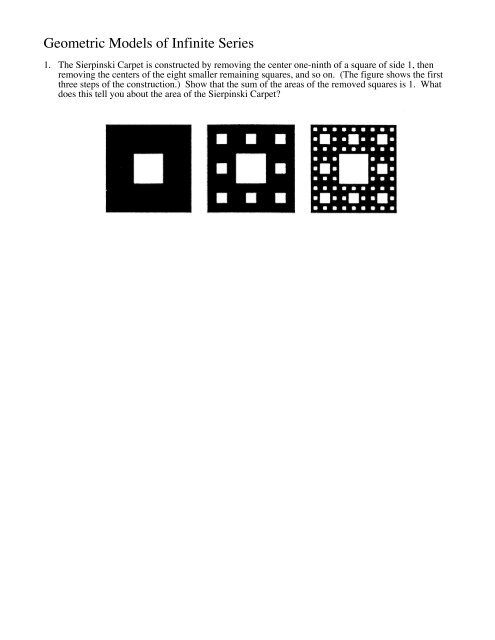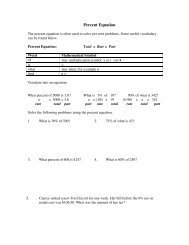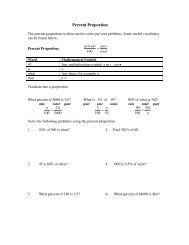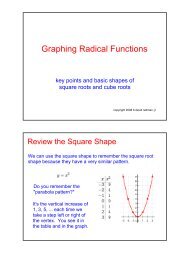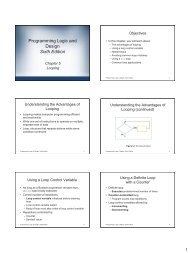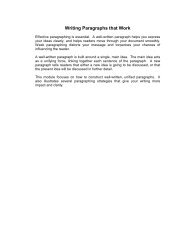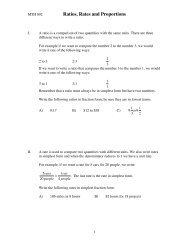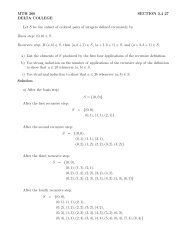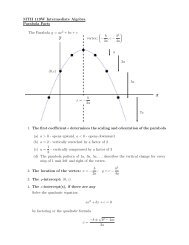Geometric Models of Infinite Series
Geometric Models of Infinite Series
Geometric Models of Infinite Series
You also want an ePaper? Increase the reach of your titles
YUMPU automatically turns print PDFs into web optimized ePapers that Google loves.
<strong>Geometric</strong> <strong>Models</strong> <strong>of</strong> <strong>Infinite</strong> <strong>Series</strong>1. The Sierpinski Carpet is constructed by removing the center one-ninth <strong>of</strong> a square <strong>of</strong> side 1, thenremoving the centers <strong>of</strong> the eight smaller remaining squares, and so on. (The figure shows the firstthree steps <strong>of</strong> the construction.) Show that the sum <strong>of</strong> the areas <strong>of</strong> the removed squares is 1. Whatdoes this tell you about the area <strong>of</strong> the Sierpinski Carpet?
2. A right triangle ABC is given with ∠A = θ and |AC| = b. CD is drawn perpendicular to AB, DE isdrawn perpendicular to BC, EF ⊥ AB, and this process is continued indefinitely as in the figure.Find the total length <strong>of</strong> all the perpendiculars, |CD| + |DE| + |EF| + |FG| + … , in terms <strong>of</strong> b and θ.
3. To construct thesnowflake curve startwith an equilateraltriangle with sides <strong>of</strong>length 1.Step 1 in theconstruction is todivide each side intothree equal parts,construct anequilateral triangleon the middle part,and then delete themiddle part.Step 2 is to repeatstep 1 for each side<strong>of</strong> the resultingpolygon.This process isrepeated at eachsucceeding step.The snowflakecurve is the curvethat results fromrepeating thisprocess indefinitely.a) Complete the following table.Steps n , thenumber <strong>of</strong>sidesl n , the length <strong>of</strong> asidep n , the total length <strong>of</strong>the nth approximatingcurveA n , the area enclosed bythe snowflake curve01234Find formulas for s n , l n , and p n .nb) Show that p n , → ∞ as n → ∞.c) Sum an infinite series to find the area enclosed by the snowflake curve.d) What "strange" relationship do parts (b) and (c) show between the snowflake curve's perimeterand area.
4. Square ABCD has sides <strong>of</strong> length 1. Square EFGH is formed by connecting the midpoints <strong>of</strong> thesides <strong>of</strong> the first square, as shown in the figure. Assume that the pattern <strong>of</strong> shaded regions in thesquare is continued indefinitely. What is the total area <strong>of</strong> the shaded regions?It might help to complete the following table and then look for a pattern.Stepthe length <strong>of</strong>a sidethe area <strong>of</strong> thesquare1 AB = 1 1the area <strong>of</strong> the triangle182EF = 2234
5. In the figure there are infinitely many circles approaching the vertices <strong>of</strong> an equilateral triangle, eachcircle touching other circles and sides <strong>of</strong> the triangle. If the triangle has sides <strong>of</strong> length 1, find thetotal area occupied by the circles.It might help to complete the following table and then look for a pattern.Steph, height <strong>of</strong> thetriangles, length <strong>of</strong> the side<strong>of</strong> the triangles = 2 3 hr, radius <strong>of</strong> the A, area <strong>of</strong> the circlecircler = 3A = π r 26 s1 31 32 6π ⎜ ⎛ 3⎝ ⎠ ⎟⎞26 234


